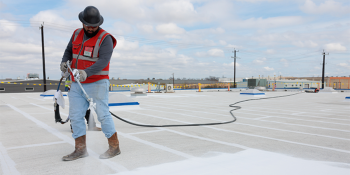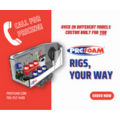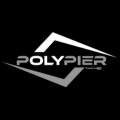Spray Foam Architect's Guide

Spray Polyurethane Foam Guide for Architects and Specifiers
Architects, designers, and engineers have utilized the many benefits and unique characteristics of spray polyurethane foam (SPF) for nearly half a century. SPF is a versatile energy efficient material that provides many solutions for the residential and commercial construction markets.
- SPF is
changing the way homes and commercial
buildings are constructed, in accordance modern
building science goals: greater energy efficiency and lasting durability.
- SPF
Insulation combines high
thermal resistance (R-value) with air
and vapor barrier properties, and in some cases strengthening
properties.
- SPF
Roofing Systems provide commercial building owners with lightweight,
monolithic, energy-saving, and sustainable roofing options. SPF has also proven
itself as a very strong performer against conventional roof systems in
hurricanes and other high-wind events.
- SPF
Adhesives have become the preferred method of installing roof board
insulation, roof coverings, and tile roofing, versus mechanical fasteners,
which can lead to water intrusion and thermal bridging.
- SPF Sealants
are the ideal solution for air sealing and weatherization applications by shoring
up gaps in door and window assemblies and cracks in the building envelope.
Consumers and facility managers are becoming more educated and more demanding about the building materials used in the construction of their properties. They are seeking the best, highest-performing, and sustainable materials to benefit their buildings, the buildings’ occupants, and their bottom line. At face value, spray foam appears more expensive than alternative insulating materials, but a mere luxury good it is not; it can actually help to save on operating costs and create much greater value and performance over time.
Considering the impact of spray foam’s unique characteristics–robust insulation characteristics plus air and vapor barrier properties–on a home or building’s energy consumption, monthly savings on energy bills can recoup the additional cost of SPF in the span of a few years. You get what you pay for, and with spray foam, you get a combination of performance characteristics no other building product can offer by itself. For example, competing insulation materials such as fiberglass and cellulose simply don’t have the benefits of spray foam insulation; they have lower R-values and don’t have air and vapor barrier properties. Furthermore, in commercial roofing, no other single material can provide a monolithic, penetration-free, self-flashing, high-insulation, strength-enhancing solution like spray foam can.
Additionally, by performing more than one function, SPF can save builders on the costs of materials and labor during construction.
If you really look at these benefits, SPF is actually less expensive and far more valuable over time–isn’t that what sustainable design and “green” building is all about?
Building Envelopes and SPF | Commercial Air Barriers | Air, Vapor, and Moisture Barriers | Blower Door Testing | Building Strength | Foam Construction Adhesives | Commercial SPF Roofing Adhesives | Roofing Adhesives for Homes





























